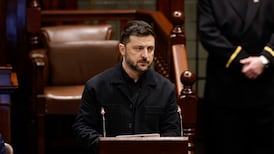ELEANOR WICKLOW was one of those people who make you wonder whether physical disability is not, at times, an advantage. The lameness which she incurred from an attack of polio in her childhood seemed only to add to her determination to tackle those obstacles which lay between her and her wide and numerous ambitions to improve the lot of travellers, to provide housing for the elderly, to brighten and beautify rural towns and villages and, above all, to bring about reconciliation in Northern Ireland. But listing these projects is to limit her because there were few good causes to which she could say "No" or turn a blind eye.
Eleanor Butler was an architect whose father had been the first Professor of Architecture in UCD, designer of the frontage to the National Concert Hall in Earlsfort Terrace. In all the undertakings in which Lady WickIow - as Eleanor later became - was involved, her skill as an architect proved invaluable. For example, a building which she, founder-member, designed for the Centre for Reconciliation at Glencree, will this year be completed and put into service.
Yet it is not so much for her many doings that Eleanor Wicklow will be remembered best by those whose lives she coloured: it will be for the enormous generosity that was in her, something that she shared with her beloved husband - the eighth Earl of Wicklow - and which no-one who knew them could ever forget. The Northern atrocities of the 1970s saw both of them continually opening their hearts and purses and often their home to refugees, frequently appearing at Connolly Station with flowers to welcome terrified people to Dublin. It was typical, too, of the "Kind Love" which they shared with so many that, in the immediate aftermath of the bombs in Dublin in 1974, they decided to dine out in Dawson Street's Hibernian Hotel because their friends, the waiters there, would be feeling so forsaken. (And true enough, few if any longer patrons sampled the menu there that night!)
As Senator Butler, before her marriage Eleanor had been a member of the Labour Party and her relationship with the trade union movement and in particular with Denis Larkin, always remained strong. As a nominee of John A. Costello's Inter-Party Government she gained experience of Europe's early Coal and Steel Community. Later she spent time in India studying political developments there.
In the 1970s an Association of Women's Voluntary Groups was formed under her chairmanship - 20 women's organisations including the Irish Countrywomen's Association, the Irish Housewives Association and the Association of Women's Clubs - which banded together at that time to address the effects of the Northern troubles. This created a momentum which eventually led to the development of such bodies as the Southern Movement for Peace, Co-operation North the Ireland Fund of America and of course the Reconciliation Centre at Glencree.
Eleanor had a gift for homemaking and for spreading colour and life around her. Her many friends have missed her sadly during her recent years of ill-health, but cannot now grudge her the Vision in which she and her devoted Billy so firmly believed. Deep sympathy goes to her sister, her relatives and to her loved companion-secretary, Judith King-Addison.










